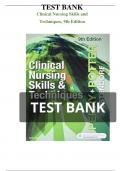Exam (elaborations)
TEST BANK Clinical Nursing Skills & Techniques 9th edition Anne Griffin Perry, Patricia A. Potter & Wendy Ostendorf
Download Test Bank for Clinical Nursing Skills & Techniques 9th edition Anne Griffin Perry, Patricia A. Potter & Wendy Ostendorf, With Full and Complete chapters Instantly,Nursing Test Bank will have you on the road to academic excellence.
[Show more]



